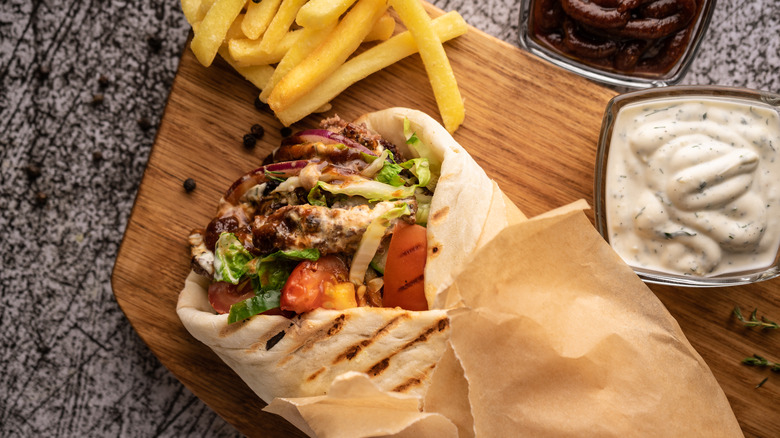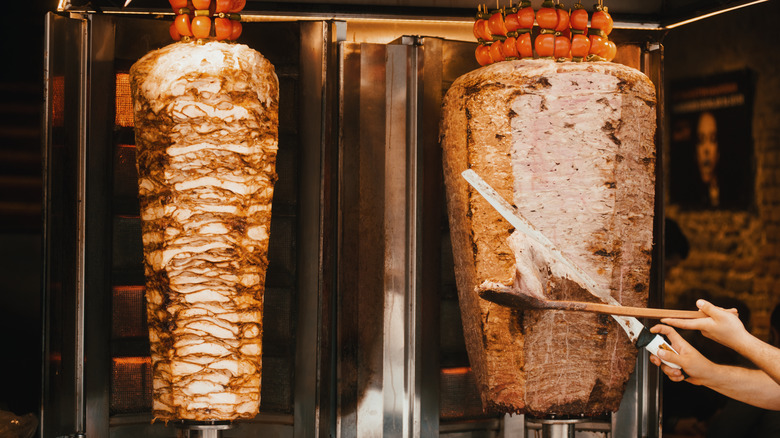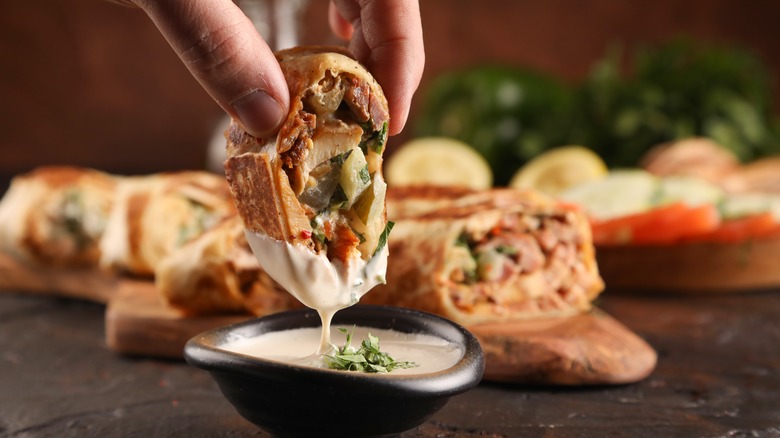What Is Shawarma And How Is It Different From Gyro?
To an outsider looking into a restaurant or street vendor specializing in shawarma or gyro sandwiches, the meat on the giant metal skewer — from which large pieces are carved off by hand — might seem mysterious. What is this meat? How is it made and seasoned? And most importantly, how do I order some?
Equally delicious, Middle Eastern shawarma and Greek gyros have similar preparation and appearance when eaten; however, the two differ considerably in flavor and toppings. Made in a comparable fashion, pounds of both marinated shawarma and gyro meat are stacked on a skewer in a cone shape and rotated to cook slowly next to a heat source. When it's done, the meat is carefully shaved to order, often by hand with a large knife. It's literally a carnivore's dream come true. While both shawarma and gyros are served with fresh toppings and sauce on pita or flatbread, it's really all about the flavorful meat.
A flavorful history
Cooking meat vertically so the juices drip down and marinate the rest of the meat is a technique that has been used for many years. It dates perhaps as far back as the Ottoman Empirebut became more technologically advanced in the 1800s when a Turkish butcher invented the rolled style that is used for today's shawarma and gyros. The butcher separated a whole lamb into sections and then layered them on an upright spit, which became known as a "döner kebab," or "rolled kebab."
As the meat cooked, he carved off pieces for customers. The process of making rolled kebab spread to other Middle Eastern countries, including Syria, Lebanon, and Jordan, and eventually to the United States and Mexico (the latter is where tacos al pastor was created as a hybrid of Middle Eastern and Mexican cuisines). While adopted by many countries around the world, the origin of the word "shawarma" lies in Turkey. From the Turkish word "çevirme," which means "turning," this skewered meat certainly needs a lot of turning to create shawarma.
Shawarma relies on seasonings
The flavor of and ingredients used to make shawarma reflect its Middle Eastern history. The standard meats to be used for shawarma are lamb or mutton but have evolved to also include chicken, veal, goat, and beef. Full of flavor, common spices used for making shawarma are turmeric, cardamom, cloves, cinnamon, and garlic. Other popular seasonings include sweet paprika, coriander, and cayenne pepper.
Adding freshness to the sandwich is creamy tahini sauce and fresh toppings, such as tomatoes, cucumbers, and parsley. Pickles, hummus, and other vegetables can often be found layered on the pita or flatbread with the seasoned meat. Making shawarma is not an easy or quick process — it can take a significant amount of time to season the meat and then stack it on the skewer. And with so much meat being stacked upon each other, it can take hours for it to cook properly and may even be roasted for days before being eaten.
Gyro is seasoned with herbs
Although similar in appearance and cooking process, the gyro is not to be confused with shawarma. Originating in Greece, the name "gyro" means "round," which refers to how the meat is roasted vertically on the skewer in front of a heat source. Like shawarma, the gyro is said to have a long history. With the Greek meat sandwich, its origins may go back to Alexander the Great's army, which cooked skewered meat over fire.
The Greeks traditionally make their gyros from pork but are known to also use chicken. In the United States, where gyros have become popular at Greek restaurants and family-style diners, gyro meat is most commonly a blend of ground beef and lamb. In both countries, the typical gyro seasoning is a blend of herbs such as rosemary, thyme, and oregano. And all gyros are typically served with tzatziki sauce, tomato, and red onion on pita bread — although lettuce will sometimes be placed on gyros in the U.S. While restaurant-style of gyros are most often served with fries on the side, street vendors may stack the fries directly on the sandwich for ease of serving and eating.



